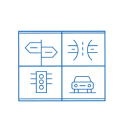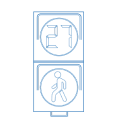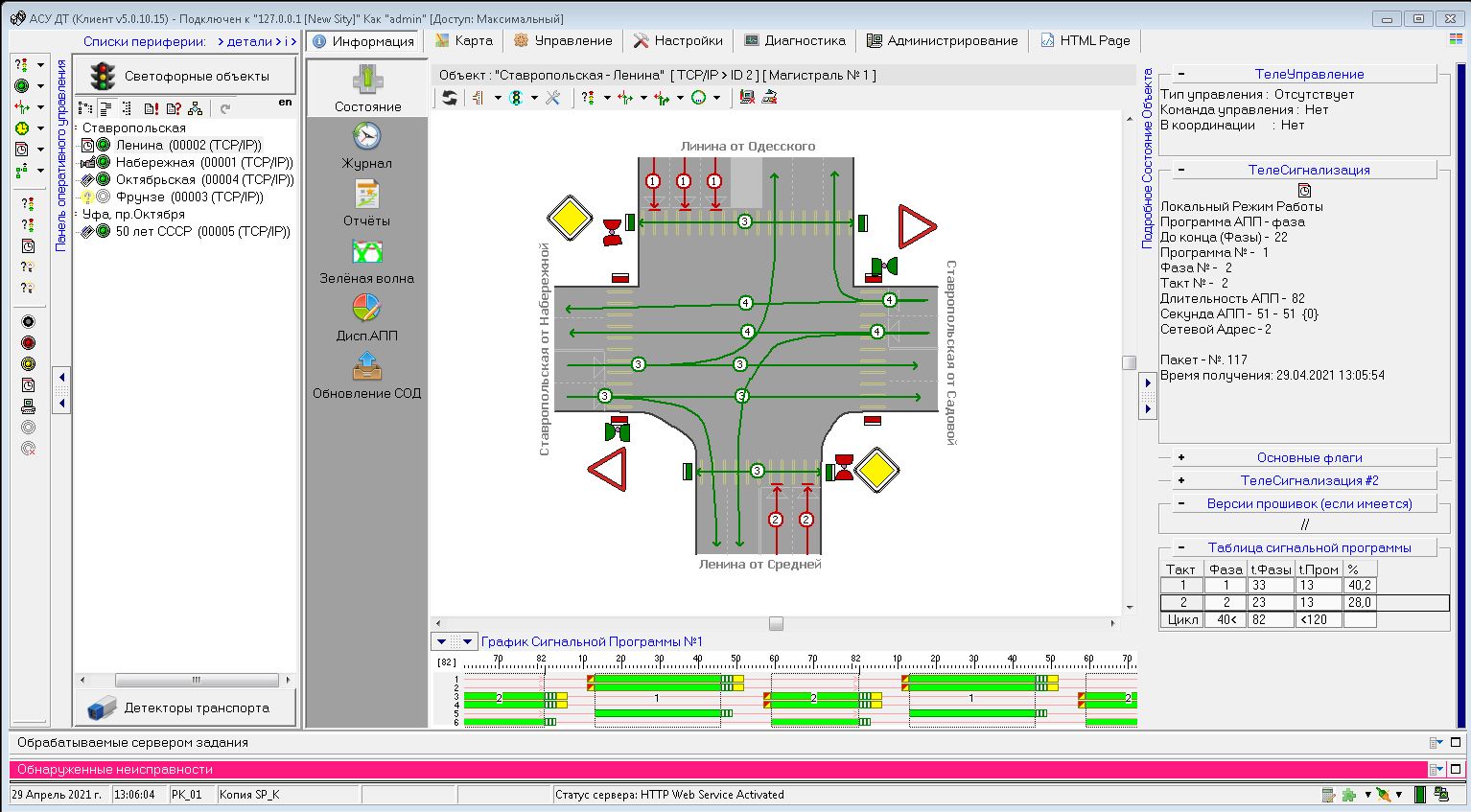ATCS
Each year sees greatly increasing urban traffic volumes, densities and intensities resulting into growing number of traffic jams.
The ATCS is designed primarily for improving traffic control efficiency at traffic lights, reducing the total number of vehicle delay at intersections, and ensuring greater comfort and safety for travelers while reducing harmful emission.


The core components of the automated traffic control system include:

Vehicle detectors

Smart road controllers

Top level software
Network connection circuits
Network interfaces between field hardware at intersections and ATCS central software via encrypted wired and wireless communication channels.










Traffic control level
Improving controls increase road network throughput overall.

Control Algorithms
Various traffic control patterns and algorithms are used throughout cities The most efficient solutions for improving of traffic conditions may be found on a case by case basis.
Local Adaptation
Adaptive control system performance is visible even at individual intersections. It requires no traffic control centers as all the hardware is within the traffic light.

Video detectors provide continuous traffic flow parameter information for all directions and lanes. The road controller receives the information and processes it depending on the selected algorithm to streamline phase durations for specific traffic directions.
Network Adaptation
Usage of control centers enhances traffic control capabilities. All controllers and peripherals form a common network using wired and wireless communications. It allows reaching a new level, that of network adaptation.
- Centralized control of entire cities from a common point;
- Prompt response to contingencies (traffic accidents, traffic jams, vehicle failures);
- Video monitoring of traffic conditions at all intersections;
- Getting information on current statuses of all field equipment pieces.

- Remote setup of controller and hardware operating modes;
- Graphical display of traffic processes at intersections;
- Display of system messages and automatic SMS and email forwarding thereof;
- Centralized database maintenance with all parameters, and graphical display thereof;
- Multiple system access levels with various powers (5 access levels);
- Traffic incident and jam identification system;
- Public transit prioritization;
- Mobile device management (Android and iOS support);
- Light Web interface versions;
- adaptive control of traffic light groups relying on vehicle detectors;
- flexible daily coordination plans;
- green times and green streets;
- adaptive green times.
"Megapolis" Software
DetailsThe software is supplied in two versions being the server solution, and the intuitive Web client.


Road controller
DetailsModular controller design simplifies its maintenance and allows enhancements of its function by adding new elements without replacing any primary equipment. Parameter Value Output Power Channels max 160 Voltage and Current Measurement for Each Key yes.
| Parameter | Value |
|---|---|
| Output Power Channels | max 160 |
| Voltage and Current Measurement for Each Key | yes |
| External Interfaces | Ethernet, RS-232, RS-485, TTL |
| Clock Adjustment Method | NTP, GPS-Глонасс |
| Smart Traffic Light Support | yes |
| Dynamic Speed Indication Panel Support | yes |
| Countdown panel (via RS485) | yes |
| On-demand pedestrian traffic light panel support | yes |
| Diagnostics of traffic light equipment operating parameters | yes |
| Integration with photo and video recorders of traffic offences | yes |
| Magentic vehicle detector connectivity | yes |
Vehicle detector
DetailsVehicle detectors are versatile products installed at thoroughfares to collect traffic data or installed within hardware suites ensuring automatic traffic control at traffic light locations.

All instruments have network interface for connecting to road controllers and control centers, allow connecting multiple information recipients simultaneously, and also allow direct interfacing with road controllers (bypassing control centers) in the local adaptive control mode.
| Parameter | Value |
|---|---|
| Detection Ranges | max 10 lanes |
| Resolution | 2 Mn/HDTV 1080p at 30 fps |
| Encoding Formats | H264, H265, Motion JPEG |
| Network Interface | RJ-45 for 10BASE-T/00BASE-TX |
| Max Power Consumption | max 6.5 W |
| Max Power Consumption (Heating Included) | max 27 W |
| PoE Support | yes |
| Operating Temperature Range | - 45С/ +50С |
| Ingress Protection | IP 67 |
| Body Material | aluminum |
Surveillance Cameras
Surveillance cameras installed at traffic lights ensure round the clock monitoring of traffic conditions and rapid responses to contingencies as well as video streaming to customer servers.

Intersection video surveillance suites include fixed cameras for each of the traffic directions as well as circular scanning dome cameras controllable remotely from traffic control centers to allow prompt assessments of traffic conditions at any intersection areas.
Video surveillance covers all traffic directions at intersectionsе
Recognition
Video streaming from all sides of intersections is continuous. Servers retain videos for 30 days minimum. Operators may use motorcar license plates at any time to request motorcar routes and intersection passing times.
- Motorcar license plates;
- Vehicle types;
- Vehicle makes and models;
- Photos of vehicles passing intersections;
- Videos of vehicles passing intersections.

Neural Networks
Awareness of individual routes of all individual motorcars allows us to forecast the urban traffic conditions overall. It improves quality of traffic control solutions. The system reviews routes of various vehicle types and models.
ATCS Implementation Outcomes






We offer integrated turnkey solutions for streamlining urban traffic control.
- Outfitting traffic lights with new vehicle detectors, road controllers and switching hardware, replacing countdown panels (if necessary)
- Installing ATCS software at situation centers (data centers, traffic data centers) for monitoring and controlling all field hardware
- Connecting field hardware, configuring road controllers subject to existing work plans (no changes here)
- Collecting traffic statistics from detectors for each direction and lane
- Modeling traffic light operation relying on road transport data for identification of the best new operating architecture of traffic lights (adding arrows if required, segregating traffic flows in counterdirections, etc.)
- Changing traffic organization at traffic lights (if required). Installing arrows, signs, etc.
- Switching road controllers to new programs, including adaptive traffic control modes
- Collecting statistical data from vehicle detectors under new operating modes, determining intersection throughput increase percentages, providing detailed reports
If required, our team will perform an audit of traffic lights, modeling and reconfiguration of road controller operating modes without installing any hardware.
"Korda ATCS" Mobile App
Korda ATCS software for mobile devices installs onto tablets and mobile phones of administrators, operators, repair team members, and managers of traffic control centers.
The software (SW) ensures monitoring of traffic lights and peripherals, and informing of users of road controller, vehicle detector and surveillance camera operating modes.
- Authorized application access
- Intuitive graphical display of statistical data for all connected traffic lights in the same screen, and indication of their statuses
- Traffic Light Search in Lists
- Real time display of reference operation details for road controllers and peripherals
- Rapid access to system logs of traffic lights and field hardware
- Real time viewing of video streams from surveillance cameras and vehicle detectors in mobile devices
- Graphical display of traffic intensity and speed data from vehicle detectors in mobile devices
- Real time informing of users of equipment failures and erros
Have an questions?

A manager will contact you shortly.